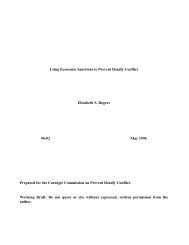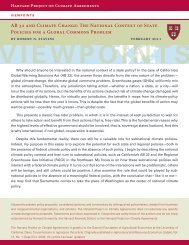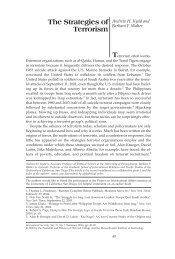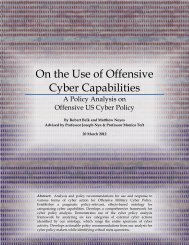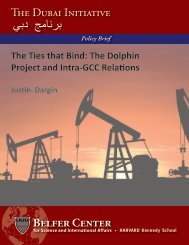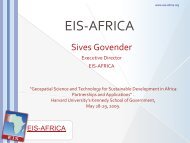Plutonium Mountain - Belfer Center for Science and International ...
Plutonium Mountain - Belfer Center for Science and International ...
Plutonium Mountain - Belfer Center for Science and International ...
- No tags were found...
You also want an ePaper? Increase the reach of your titles
YUMPU automatically turns print PDFs into web optimized ePapers that Google loves.
explosions conducted in the tunnels had actually detonated, Litvinov said they had not. This<br />
added a new concern: the plutonium (or highly enriched uranium) that remained in the test tunnels<br />
from those duds, especially now that it appeared the scavengers were re-entering some of<br />
the previously-sealed test tunnels.<br />
Lastly, Litvinov told Hecker that some of the tests had been carried out in large tank-car sized<br />
metal containers known as “Kolbas.” 42 Where were they now Still in place, at Semipalatinsk.<br />
Some were deep inside the tunnels at Degelen <strong>Mountain</strong>, others were outside.<br />
These discussions with the scientists convinced Hecker that any hope of dealing with the plutonium<br />
at Semipalatinsk would have to involve the Russians. They had the knowledge of what tests<br />
had been carried out <strong>and</strong> what might have been left behind. “What tunnels actually still contained<br />
stuff that we should be worried about” Hecker recalled asking. “Without the Russians, we have<br />
no chance whatsoever. It would be like looking <strong>for</strong> a needle in a haystack.”<br />
It would not be easy. Even in 1998, seven years after the Soviet collapse, suspicions from the<br />
Cold War still ran strong. While at Chelyabinsk-70, Hecker went to see Evgeny Avrorin, who<br />
had twice served as scientific director of the laboratory. Although he had extensive contacts with<br />
westerners over the years <strong>and</strong> had come to Los Alamos to help the lab celebrate its 50 th anniversary<br />
in 1993, Avrorin was still cautious <strong>and</strong> suspicious. The nuclear weapons laboratories had<br />
been secret kingdoms <strong>for</strong> so long that the mindset was hard to change.<br />
Hecker showed the photographs from Semipalatinsk to Avrorin, <strong>and</strong> implored him to support<br />
some ef<strong>for</strong>t to deal with the plutonium. Hecker recalled that Avrorin replied, “It sounds like intelligence<br />
to me.”<br />
Hecker added,<br />
What he was concerned about is that the work that they did there… the plutonium chemistry,<br />
the plutonium isotopics, are classified secret in Russia. …The type of test that they did,<br />
whether it was in the tunnels, whether it was in the Kolbas—that’s all part of their trade, of<br />
the nuclear weapons trade. They don’t want to give out that in<strong>for</strong>mation. And Avrorin was<br />
concerned that I was doing this <strong>for</strong> intelligence collection.<br />
Hecker recalled telling Avrorin that he was not spying but was concerned about the nuclear materials<br />
spread across the steppe, unprotected. Nonetheless, the Chelyabinsk-70 scientists decided<br />
to hold back, to see if Moscow allowed the project to move ahead, <strong>and</strong> to let Arzamas-16 go first.<br />
They eventually joined the project.<br />
Next, Hecker came back to the United States <strong>and</strong> briefed high-level officials in the government<br />
about what he had found. He showed them photographs of the unmanned guard gate, of the<br />
trenches, <strong>and</strong> maps of the various sites at Semipalatinsk where the fissile material might be located.<br />
He urged them to join Russia <strong>and</strong> Kazakhstan in an ef<strong>for</strong>t to do something about the proliferation<br />
risks at Semipalatinsk.<br />
Hecker warned them that the amount of recoverable plutonium was not trivial. He said there<br />
was perhaps as much as 200 kilograms, or about 441 pounds, enough <strong>for</strong> at least a dozen nuclear<br />
weapons <strong>and</strong> maybe more, given the quality of the material. And it was all lying about,<br />
42<br />
“Kolba” is a term of art in chemistry to refer to containment chambers.<br />
16<br />
<strong>Plutonium</strong> <strong>Mountain</strong>: Inside the 17-year mission to secure a dangerous legacy of Soviet nuclear testing



